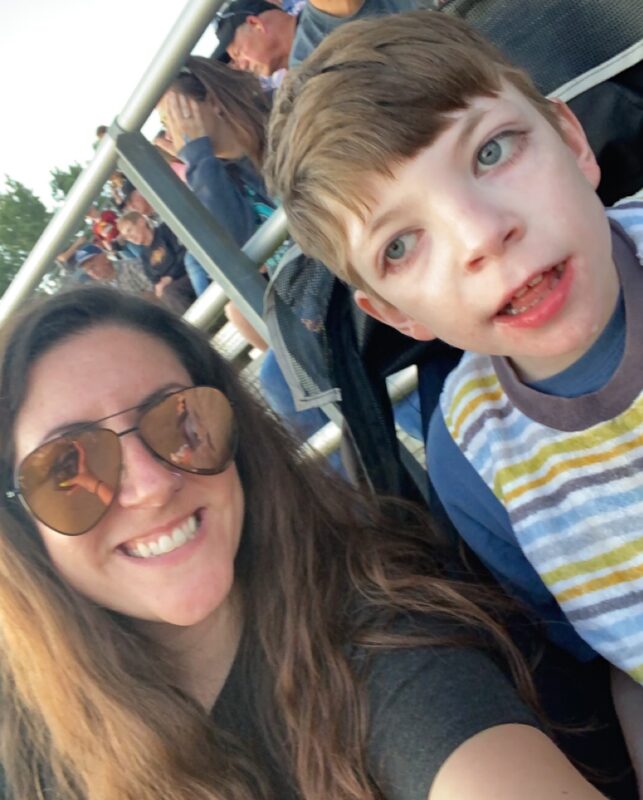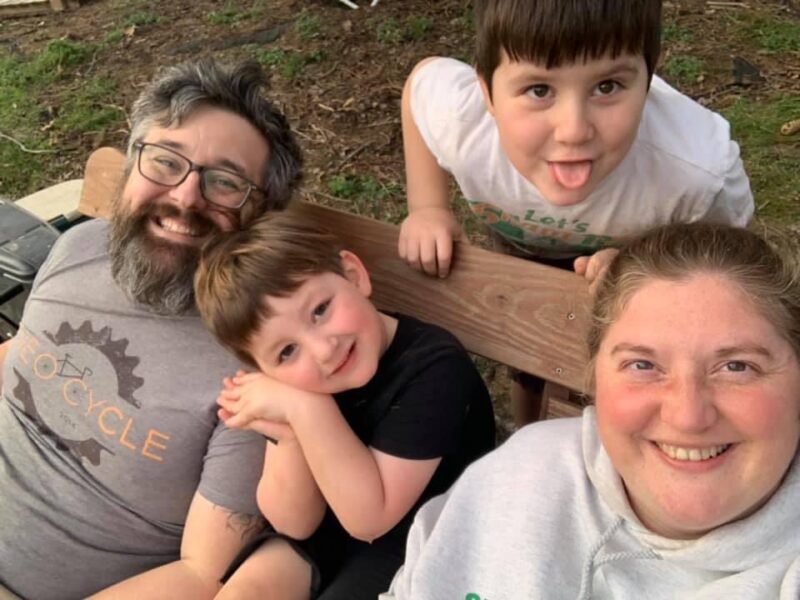
Sawyer Okel, 7, loves to help in the kitchen. Here, he’s making a good keto breakfast of sunny-side up eggs featuring extra butter and mayo.
A diet where generous amounts of oil, butter, mayonnaise and heavy cream are encouraged may sound odd but it’s keeping dozens of Akron Children’s patients seizure free and restoring normalcy to their lives. That makes parents and doctors big advocates of the medical keto diet for children whose seizures do not respond well to anti-epileptic medications.
The medical keto diet is not to be confused with fad “keto” diets marketed to adults, said Elizabeth Song-Pozderac, the dietitian who works in the epilepsy program. “Keto” has become a buzz word in that realm, slapped on food packages and is generally the word is associated with high-protein, low carb diets.
The medical keto diet that can help control seizures is a “very high fat, normal protein, very low carb” diet. Patients are closely monitored by a team of providers, including a pediatric epileptologist, a nurse practitioner, registered nurses, and a dietitian.
The goal is to bring the body to a state of ketosis and keep it there.
“Our brains typically use carbohydrates as a fuel source,” said Song-Pozderac. “Our goal is for these kiddos to start using fat, converted to ketones, in place of carbohydrates.”
A good rule of thumb for those starting the medical keto diet: “If you think your child is eating too much fat, it probably isn’t enough,” said Song-Pozderac. “If you say you had eggs for breakfast, I am going to ask if you added oil, heavy cream and/or avocado? We always say, “There’s no such thing as too much fat on this diet.”
In general, kids on the medical keto diet generally get between 70 to 80 percent of their calories from fats, 20 percent from proteins, and 5 to 10 percent from carbohydrates, said Dr. Lucyna Zawadzki, director of Akron Children’s Pediatric Epilepsy Program.

Dr. Lucyna Zawadzki is a pediatric epileptologist.
“This has to be sustained every day, every meal, every snack,” Dr. Zawadzki said. “You can’t cheat on it like you can a fad diet.”
While the association between the high-fat diet and seizure reduction has been known for more than a century, the exact mechanisms at play remain unknown.
“Ongoing research shows the low blood sugar and ketosis affect the brain in multiple ways. The pathways are complicated but the end effect is a reduction of the excessive firing of neurons and in seizure activity,” said Dr. Zawadzki.
The diet is a considered a treatment. It is in use around the world and an international medical keto conference is held every other year for the sharing of research and best practices.
“We have a lot of experience as an epilepsy community with this therapy and current research is also looking at its expanded uses to benefit patients with such conditions as traumatic brain injury, Alzheimer’s Disease, Parkinson’s Disease, auto-immune disorders and other conditions,” said Dr. Zawadzki.
Patients are considered for the medical keto diet when their seizures have not been managed by medication. Family support is also an important consideration as it is not an easy diet to follow.
Akron Children’s currently has more than 40 patients on the diet ranging in age from age 2 to 25. It might take weeks or months to see full results.

Elizabeth Song-Pozderac is the dietitian who works with Neurology patients on the medical keto diet.
“Before they start on the diet, we offer extended education and do a full panel of labs to make sure it’s safe for them,” said Song-Pozderac. “We follow up in a month and then every three months we do more labs.”
Meanwhile, at home, parents monitor ketones day to day using urine strips and blood sugars. There’s a fair amount of individuality. Some kids do fine in low ranges of ketosis, while others need to be in high ranges for stability.
“This diet must be supervised to watch for potential side effects [like constipation and kidney stones] and to make sure the body is getting its nutritional needs,” said Dr. Zawadzki. “The program has to be specifically designed for each patient based on their age and body size.”
If the kids remain in ketosis, they should not gain weight despite the common association between a high-fat diet and weight gain. Growth is closely monitored, with calories being adjusted as needed.
While the team does not expect families to count their fat and protein intake, they do have to count their net carb intake. Clinic visits confirm if the child is in ketosis and seeing results (fewer seizures). If not, they will be directed to adjust protein and carbs and add fat.
The diet does not just help with seizure control. It can help improve focus and alertness, especially if the child can be taken off some or all of their epilepsy medications.
Canton mom says keto diet is nothing short of a ‘miracle’ for her son
Athena Pellegrini, of Canton, described the seizures that controlled her son’s life as horrific.
“Ramsey had thousands of seizures a day – like every couple of seconds,” she said. “They just never stopped and so he could never be left alone, and they eventually stopped letting him come to school.”
Ramsey, now 13, started on an enteral (tube fed) keto diet nearly 7 years ago. At first, the months passed with no results.
“I was losing hope and, then, one day, he woke up and I noticed he hadn’t had a seizure,” Athena said. “I don’t know if it took that long for his body to switch over to ketosis, but it was like night and day. He went from thousands of seizures a day to just a handful. Fast forward and he hasn’t had a seizure in two years.”

Athena Pelligrini and son Ramsey have been enjoying life more fully since he has been able to control his seizures through a medical keto diet.
The improvement in Ramsey’s quality of life is nothing short of miraculous. No longer paralyzed by seizures, he went from a boy who had trouble holding up his head and standing on his own to one who runs and jumps and is gaining weight and growing. He once again attends school full-time.
He is advancing academically and has the energy to pursue his passions – cars, trucks, motorcycles, and attending tractor pulls throughout the summer.
“He loves to be outdoors, and he loves anything loud,” said Athena. “His life is just 1,000 percent better. I am glad we waited for this to work and that’s the advice I would give to other parents. Give it time. It’s crazy to think he is on a diet that so high in fat and no carbs and the yet the amount of energy he has – he is just go, go, go all day.”

13-year-old Ramsey was able to return to school full-time after him medical keto diet began to control his seizures.
A diet rich in butter and oil has kept a Copley boy seizure free for 3 years
Sawyer Okel was just past his third birthday when he had his first grand mal seizure. He had no issues at birth or until then, so it caught his parents off guard. Just a few weeks later, Sawyer and his older brother, Tucker, were performing Irish step dancing at a parade and social gathering when he had his second seizure. The event was full of police officers and firefighters who provided quick emergency care. But things quickly went from bad to worse.
Sawyer developed myoclonic jerks that could cause serious injury.
“This was pretty traumatic and hard,” said his mother, Ashley. “Now he wasn’t allowed to use stairs or climb things and he was 3 and loved all of that. We got him a soft-sided helmet and being cautious became part of our everyday life. There was no ability to see something coming.”
The myoclonic jerks transitioned into atonic drops. Sawyer could be sitting, standing or walking and mid-stride he would suddenly fall like a rag doll.
Before his 4th birthday Sawyer began seeing Dr. Zawadzki, who guided the family through genetic testing and tried Sawyer on several medications and combinations of medicines, all of which ultimately didn’t help him much.
“We were running out of options, and this (the medical keto diet) was kind of a last-ditch effort,” said Ashley. “It seemed daunting but manageable. We made a plan for shifting him to the new diet beginning with a keto snack every day. Then we added a meal and kept progressing until he was full keto.”
Song-Pozderac offered advice on how to keep Sawyer on keto without needing to prepare two separate dinners. As an example, the whole family can eat fajitas together with Sawyer swapping onions because they are higher in carbs with extra-large dollops of full-fat sour cream.
Ashley doesn’t want Sawyer to miss out on the childhood pleasure of Popsicles, so she makes her own with Gatorade Zero.
Instead of cookies, kids on this diet can be treated to “fat bombs,” homemade snacks made with a fat (cream cheese, butter, peanut butter), small amounts of flavor (extracts, dark chocolate, spices) and textures (almonds, walnuts, chia seeds, bacon bits, shredded unsweetened coconut) to name just a few of the variations.
Sawyer, who is also on medication, eats no more than 20 carbs per day and they must be spread out and consumed with a high amount of fat.
“Basically, we count carbs and dump oil and butter on everything,” Ashley said, adding, “we do closely monitor his cholesterol and can switch to plant-based fats like avocado oil butter or straight avocado as main food staples.”
Sawyer, now 7, has not had a seizure in three years.
“This has given him a life,” said Ashley. “He pretty much operates like a normal kid. He can go to school. He goes to dance class. He plays sports – he’ll never be able to play football or anything else where he gets hit in the head but that’s alright. I’ll teach him to golf.”

Life has improved dramatically for the Sawyer family, of Copley, since younger son, Sawyer, began the medical keto diet and stopped having seizures.










